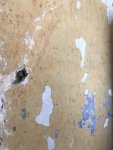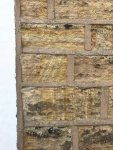Hi,
Hoping someone will be able to help answer a question about lime skimming (pictures attached).
I've recently moved into an 1860 solid stone cottage with lime plaster used throughout the internal walls. I intend to stay true to the original specs by using lime on the 'outer' internal walls so the building can breath.
I'm currently looking for a lime plasterer near Manchester but want to do as much prep work as I can during lockdown.
I'm working my way through layers of wallpaper and have reached the top layer of plaster which looks like a gypsum skim painted with an old, glossy paint. I'm able to chip away the skim and can now see the lime plaster beneath (white in photos). The lime plaster looks in pretty good condition, apart from a few bits that'll need a patch / skrim. From what I understand, the gypsum skim and paint will need to come off to allow the lime plaster to breath again.
My questions is, to make an assessment and job easier for the plasterer, should I continue to chip off the gypsum skim and get down to the lime?
It'll take me some time to do but I've got plenty of that right now. In the end, I'm hoping that the old lime might be in good enough condition for a new lime skim opposed to building up from scratch.
Thanks in advance for replies and to those who contribute to the site - have found it really helpful so far.
Cheers,
Baz
Hoping someone will be able to help answer a question about lime skimming (pictures attached).
I've recently moved into an 1860 solid stone cottage with lime plaster used throughout the internal walls. I intend to stay true to the original specs by using lime on the 'outer' internal walls so the building can breath.
I'm currently looking for a lime plasterer near Manchester but want to do as much prep work as I can during lockdown.
I'm working my way through layers of wallpaper and have reached the top layer of plaster which looks like a gypsum skim painted with an old, glossy paint. I'm able to chip away the skim and can now see the lime plaster beneath (white in photos). The lime plaster looks in pretty good condition, apart from a few bits that'll need a patch / skrim. From what I understand, the gypsum skim and paint will need to come off to allow the lime plaster to breath again.
My questions is, to make an assessment and job easier for the plasterer, should I continue to chip off the gypsum skim and get down to the lime?
It'll take me some time to do but I've got plenty of that right now. In the end, I'm hoping that the old lime might be in good enough condition for a new lime skim opposed to building up from scratch.
Thanks in advance for replies and to those who contribute to the site - have found it really helpful so far.
Cheers,
Baz



